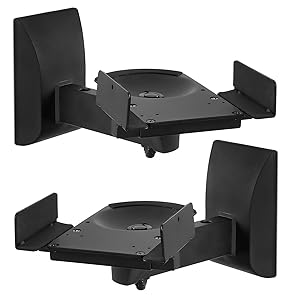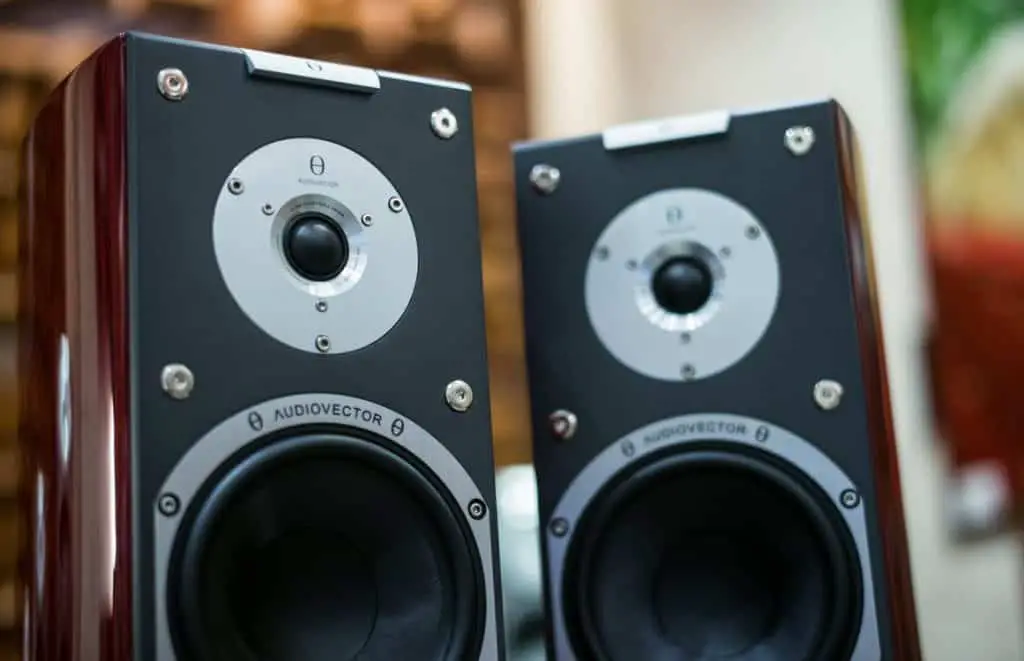As an Amazon Associate we earn from qualifying purchases.
A music studio isn’t complete without studio monitors. They are used to produce the purest and clearest sounds without any coloring. Once you choose the right studio monitors, an important aspect is finding the right placement. You can either place them directly on your desk or mount them on the wall. So, you may require studio monitor wall mounts.
at a glance: our top 5 picks for studio monitor wall mounts
Near-field monitors that need to be in the direct line of your hearing are often placed on top of desks. In other settings, they are placed on floor-mounted stands. Bigger monitors, the mid-field and far-field ones, can be placed farther from the listener. They are usually placed on wall mounts.
Wall mounts are not recommended for near-field monitors. One reason is that wall mounts are usually a lot farther from the listener than recommended. Another reason is that wall mounts place them closer to the wall than recommended. Placing a near-field monitor too close to the wall is a surefire way to diminish its bass production.
That being said, some near-field monitors are designed in a way that they can be placed on wall mounts without compromising the bass output. Their enclosure and driver directions are chosen so that even when mounted, the monitor produces clear output.
QUICK OVERVIEW: OUR TOP PICKS FOR STUDIO MONITOR WALL MOUNTS
| Image | Product | |
|---|---|---|
Our Top Pick  | VideoSecu MS56B 3LH
| View On Amazon → |
 | WALI Dual Side Clamping Bookshelf Speaker Wall Mounting Bracket
| View On Amazon → |
 | Mount-It! Speaker Wall Mounts (MI-SB37)
| View On Amazon → |
 | Pair Rockville RHSB8 Wall Mount
| View On Amazon → |
 | Hidden Wall Mount Swivel Brackets for KRK RP5G3W
| View On Amazon → |
If you are choosing a wall mount for your near field studio monitor instead of floor mount stands, two major factors you need to consider are:
Table of Contents
The Distance of Mounted Monitor from the Wall
How far will the monitor be from the wall once you have affixed it onto a wall mount? The distance is usually very small, less than 6-inches in most cases. The optimal distance of a monitor from the wall is 6-inches to 12-inches.
Can Your Studio Monitor Handle it?
As we said, some studio monitors are especially designed to be placed near a wall without disrupting the bass production of the monitor. If your near-field monitor can handle being near the wall, you can place them on a wall mount. Make sure where you sit to listen is at the optimal distance from the monitors.
If a monitor is placed too close to a wall, or any hard surface, it suffers from a phenomenon called SBIR.
SBIR
Speaker Boundary Interference Response. This refers to the effect a studio monitor or a speaker has when it is placed too close to a hard surface. The surface can be floor, ground, wall or the desk. This is especially true for lower frequencies.
High frequencies are very directional. Similarly, low frequencies are very spherical. When a studio monitor is placed too close to a wall and it starts producing sounds below 125 Hz, the bass sounds are almost spherical. What it means is that you are hearing the sound coming directly towards you from the monitor, and echoing from the wall at the back of the monitor.
When these sounds collide, the interference can distort the sound you hear or record. This SBIR phenomenon is important to understand when you are choosing to go with the wall mount for your studio monitors.
If you want to eliminate the SBIR, an option to look at is soffit mounting. Soffit mounting refers to an especially designed cavity in the wall to place the studio monitor in it. There are some characteristic differences between soffit mounting and wall mounting.
Soffit vs. Wall Mount
Soffit mounting, with some acoustic treatment, can eliminate the effects of the monitor being near the wall. The problem with soffit mounting is the care it needs in designing and the rigidity of the structure. Once you design soffit mounts for a specific pair of monitors, it might not be ideal from another.
Wall mounts are flexible; they allow studio monitors to be redirected from side to side and up to down. Mounts can usually handle many different types and dimensions of studio monitors. On the flip side, they offer no particular protection against back wall reflection.
Soffit mountings take a bigger bite out of your budget than the wall mounts do.
Factors to Consider Before Choosing the Wall Mount
The right wall mount can be chosen looking at a number of factors.
Weight Capacity
How much weight can the studio mount handle? This is an important consideration. Since studio monitors, especially mid-field and far-field ones, are quite heavy. The wall mount weight capacity should be able to handle the weight of your monitor with some to spare.
How you anchor your wall mount plays an important role in that too. A poorly anchored wall mount, even if it can handle the weight of your monitor, may fall down and damage the wall and the monitor.
Swivel Angle
One of the reasons to choose a wall mount over soffit mounting is the flexibility it offers. A wall mount allows you to change its angle horizontally. The greater the swivel allowed in a wall mount, the more it can turn to the right or the left. This allows you to manage your sweet spot.
Tilt Angle
Apart from the horizontal movement, a wall mount should have the flexibility to tilt up and down too. This helps a lot if you have to place your studio monitors high up on the wall. When the mount allows for a tilt, you can direct the monitor down towards yourself.
Adjustable Width
Another important feature a wall mount can have is adjustable width. Most wall mounts, allow for a clamp of the monitors. If a monitor cannot be affixed on the mount using screws, the clamps can firmly hold it in its place.
The clamping width is usually adjustable, which means you can fit in a variety of monitors on a single wall mount.
Five Good Studio Monitor Wall Mounts
Considering all the factors, here is our list for the five good studio monitor wall mounts you can find.
1. VideoSecu MS56B 3LH
VideoSecu MS56B 3LH are pair of sturdy, steel-made wall mounts that can support studio monitors up to 13-inch deep. The strong clamp allows for an easy fixture of monitors that do not allow screws. A bigger wall plate allows for efficient anchoring. Wall plate cover displays a pleasant outlook.
Weight Capacity: 33 lbs
Swivel Angle: 360 degrees
Tilt Angle: 10 degrees
Adjustable Width: 5.3-inches to 11-inches
2. WALI Dual Side Clamping Bookshelf Speaker Wall Mounting Bracket
WALI Dual Side wall mounts are suitable for studio monitors, bookshelf speakers and Hi-Fi speakers alike. They are sleek in design and durable. The construction is designed to be especially safe against the vibrations. The monitor placement plate is a good 6.3-inch away from the wall mount.
Weight Capacity: 55 lbs
Swivel Angle: 45 degrees either side
Tilt Angle: 7.5 degrees either side
Adjustable Width: 5.3-inches to 11-inches
3. Mount-It! Speaker Wall Mounts (MI-SB37)
Mount-It are easy-to-install heavy duty wall mounts are good for a variety of studio monitors. Elegantly designed and colored black, they have a strong anchoring configuration. The clamps are strong and can hold a monitor weighing up to 55 lbs.
Weight Capacity: 55 lbs
Swivel Angle: 180 degrees
Tilt Angle: 7.5 degrees either side
Adjustable Width: 5.4-inches to 11-inches
4. Pair Rockville RHSB8 Wall Mount
Pair Rocville RHSB8 is a beautifully designed pair that is also made from heavy-duty steel. The side clamps are added with screw holes for extra support. The pair comes with non-slip isolation pads to prevent the monitors from vibrating too much.
Weight Capacity: 40 lbs
Swivel Angle: 180 degrees either side
Tilt Angle: 10 degrees
Adjustable Width: 5.5-inches to 12-inches
5. Hidden Wall Mount Swivel Brackets for KRK RP5G3W
Closing the list is a pair of hidden wall mounts for the KRK R5G3W monitor. The mounts are designed in a way that they hide when the monitors are mounted. They are made of aluminum, and lighter than their steel pairs but still durable.
Weight Capacity: 33 lbs
Swivel Angle: 90-degrees either side
Tilt Angle: 60 degrees
Adjustable Width: N/A
Conclusion
Every studio has its own design requirements and equipment needs. Placement of equipment and acoustic treatments are also important parts of designing a studio. Wall mounts come in handy in certain studio configurations and arrangements.
The mounts make for a placement that is a bit far from you, especially if you compare it to the desk or floor-mounted stands. Understanding the sweet spot, taking some acoustic measures and the right monitors can make the wall-mounted studio monitors work perfectly.
Amazon and the Amazon logo are trademarks of Amazon.com, Inc, or its affiliates.
